The Skylake Core i3 (51W) CPU Review: i3-6320, i3-6300 and i3-6100 Tested
by Ian Cutress on August 8, 2016 9:00 AM ESTGrand Theft Auto V
The highly anticipated iteration of the Grand Theft Auto franchise finally hit the shelves on April 14th 2015, with both AMD and NVIDIA in tow to help optimize the title. GTA doesn’t provide graphical presets, but opens up the options to users and extends the boundaries by pushing even the hardest systems to the limit using Rockstar’s Advanced Game Engine. Whether the user is flying high in the mountains with long draw distances or dealing with assorted trash in the city, when cranked up to maximum it creates stunning visuals but hard work for both the CPU and the GPU.
For our test we have scripted a version of the in-game benchmark, relying only on the final part which combines a flight scene along with an in-city drive-by followed by a tanker explosion. We record both the average frame rate and the percentage of frames under 60 FPS (16.6ms).
For this test we used the following settings with our graphics cards:
| Grand Theft Auto Settings | |||
| Resolution | Quality | ||
| Low GPU | Integrated Graphics | 1280x720 | Lowest |
| ASUS R7 240 1GB DDR3 | |||
| Medium GPU | MSI GTX 770 Lightning 2GB | 1920x1080 | Very High |
| MSI R9 285 Gaming 2G | |||
| High GPU | ASUS GTX 980 Strix 4GB | 1920x1080 | Very High |
| MSI R9 290X Gaming 4G | |||
Integrated Graphics
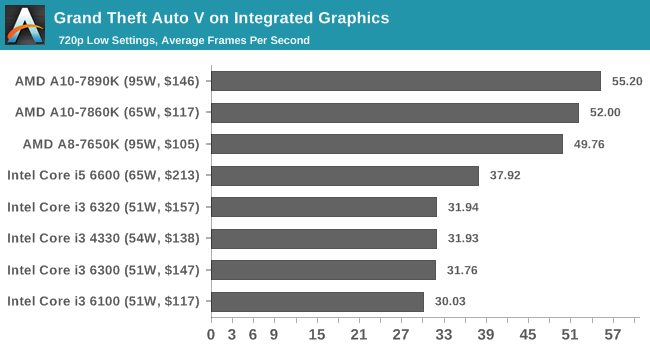
![Grand Theft Auto V on Integrated Graphics [Under 60 FPS]](https://images.anandtech.com/graphs/graph10543/83071.png)
The APUs take a large, almost double FPS lead for average frame rates, and again the Core i3 staircase shows that the L3 cache makes a difference. On the Low FPS graph, we see that none of the Intel CPUs make it above 60 FPS at any point, whereas the APUs can expect to see 15-30% of their time at or above 60 FPS.
Discrete Graphics
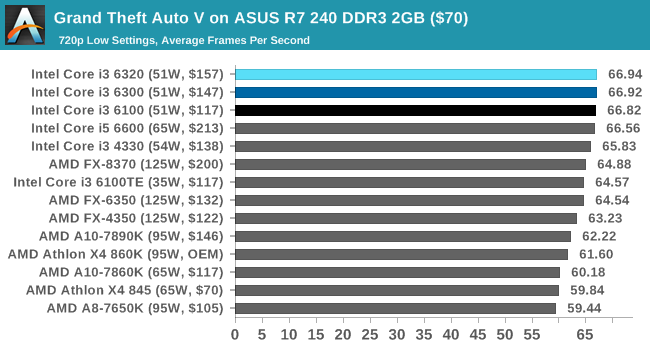
![Grand Theft Auto V on ASUS R7 240 DDR3 2GB ($70) [Under 60 FPS]](https://images.anandtech.com/graphs/graph10543/83079.png)
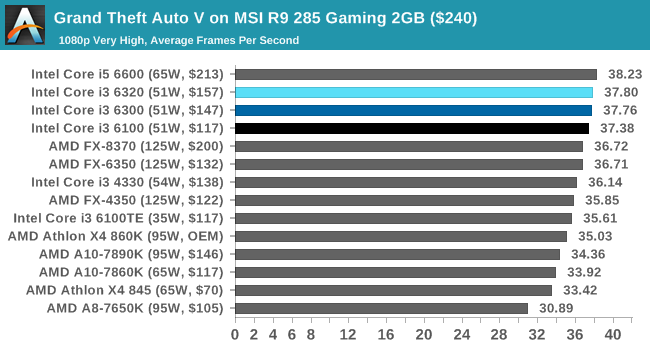
![Grand Theft Auto V on MSI R9 285 Gaming 2GB ($240) [Under 60 FPS]](https://images.anandtech.com/graphs/graph10543/83087.png)
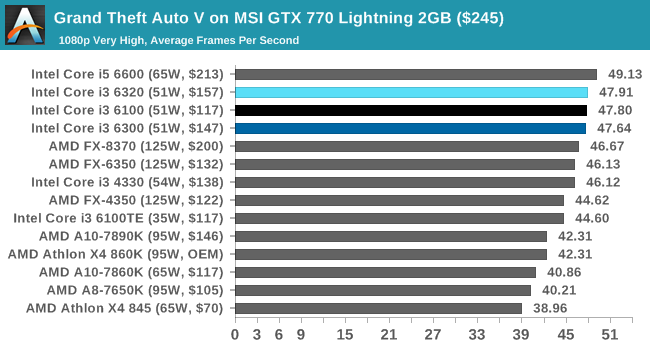
![Grand Theft Auto V on MSI GTX 770 Lightning 2GB ($245) [Under 60 FPS]](https://images.anandtech.com/graphs/graph10543/83095.png)
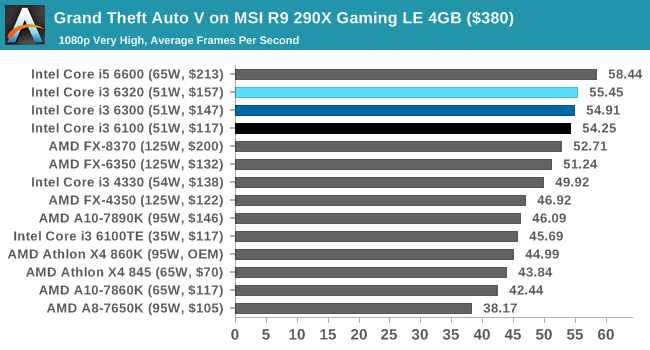
![Grand Theft Auto V on MSI R9 290X Gaming LE 4GB ($380) [Under 60 FPS]](https://images.anandtech.com/graphs/graph10543/83103.png)
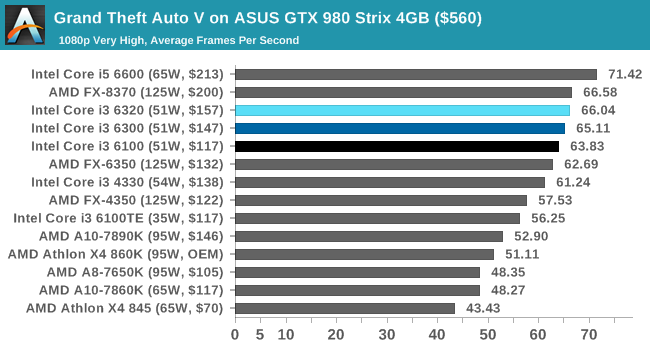
![Grand Theft Auto V on ASUS GTX 980 Strix 4GB ($560) [Under 60 FPS]](https://images.anandtech.com/graphs/graph10543/83113.png)
It's an onslaught of data, but clicking through to each graph will expand it in finer detail.
Again, with a discrete GPU, the Core i3s sit very pretty at the top of our graphs. In most cases, against similarly priced AMD CPUs, they can be from 5% to 20% quicker in average frame rates - the higher power the GPU, the more that it matters.
An interesting graph is the final one, with the GTX 980 and lookng at the percentage of frames over 16.6ms (i.e., the percentage time the game spends under 60 FPS). With the Core i3 parts, the game spends at least 50% of its time above 60 FPS running at 1080p Very High settings, however with similarly priced AMD APUs, this drops down to 15-25%. While running at V-Sync, this will be noticable. The FX CPUs get a better showing with the GTX 980, with the FX-6350 and the FX-8350 straddling the Core i3s for average frame rates and the 60 FPS metric.











94 Comments
View All Comments
jabber - Tuesday, August 9, 2016 - link
Yeah, unfortunately, a lot of IT guys assume that because they run quad cores at 100% all day long with 32GB of ram that Helen on the front desk or Mike in Sales needs the same. They don't. Similar to Ratman I sell a lot of recon Dell and HP ex corporate machines to my small business customers. 2010 spec machines with dual core 3GHz Pentiums with 4-8GB of ram. They can buy three of them for the cost of a 2016 model. They love them. If they need a real boost, a 120GB SSD gets slapped in. They pee their pants with excitement when that happens. Standard business computing was finally catered for many many years ago. It hasn't really changed.BrokenCrayons - Tuesday, August 9, 2016 - link
Decrepit Core 2 Duos are indeed perfectly acceptable for poking around on the internet and handling basic office workloads. I'm fairly happy using a T2310-based laptop (C2D@1.46GHz) with 2GB of RAM and a recently purchased 500GB 5400 RPM drive for most of my day-to-day computing tasks. I can feel the system's performance catching up when I ask the Intel x3100 graphics card to chug through anything higher than 720p video on Youtube. Most of my gaming is streamed through Steam so the box on the user end isn't as important as the computer that actually runs the game with reduces my concern pretty significantly when it comes to keeping my laptop up-to-date. I'm pretty sure I can squeeze another year or two out of it before handing it over to the electronics recycling center.Like jabber says, office work has long since been addressed by technological advancements and _most_ home computing needs aside from throwing around modern games have too.
Icehawk - Tuesday, August 9, 2016 - link
We have some C2Ds at work, and yeah for a regular office job they are fine IF they have 8gb of RAM, unfortunately these machines are so old keeping them running or upgrading is a hassle. And at least here, unless you are in IT or a programmer good luck getting a SSD. A newer i3 with 8gb and SSD is definitely enough for any casual user at work or home for sure.BrokenCrayons - Wednesday, August 10, 2016 - link
It depends a lot on the workload. 2GB is sufficient for almost everything I do on a home computer except for the occasional game. In an office setting 4-8GB would be better just because workforce users tend to leave a larger number of programs open at once. I do agree that in a workplace, computers should still be replaced every 3-5 years due to upgrade and maintenance issues that crop up as they age past that point even if the system performance is still perfectly adequate.lilmoe - Monday, August 8, 2016 - link
Do tell how to spread a select query (with a join or two) on multiple equally tasked threads when you only need to query a huge table (with the others being relatively tiny).i3s are my go-to recommendation for clients needing POS stations and others that only need a client/terminal for an ERP database.
lilmoe - Monday, August 8, 2016 - link
What's being multithreaded is the UI, almost exclusively. And that's for responsiveness rather than speed, in which 2 cores more than suffice.elbert - Monday, August 8, 2016 - link
Thats not how it works. This is like arguing against dual cores because there was no threaded software. Chicken and the egg is a fun game but the process has to come first.bug77 - Tuesday, August 9, 2016 - link
There's no chicken and egg here. We've had 8 thread capable CPUs for years. But we simply don't need them at home or for typical desktop usage.They're great for 3D rendering, video editing or programming, but they're not for everyone.
elbert - Tuesday, August 9, 2016 - link
Dual cores aren't for everyone so lets just agree they should moved to a tablet or watch. Intel needs to move on 6 core Kaby Lake for the main steam at the very least.bug77 - Wednesday, August 10, 2016 - link
No, we don't agree on that. Dual core is plenty for typical web browsing and occasionally writing a paper for school. I'm on an i5 for years and I rarely see all 4 cores put to use at the same time.You're entitled to your opinion, of course, but I don't agree with it.